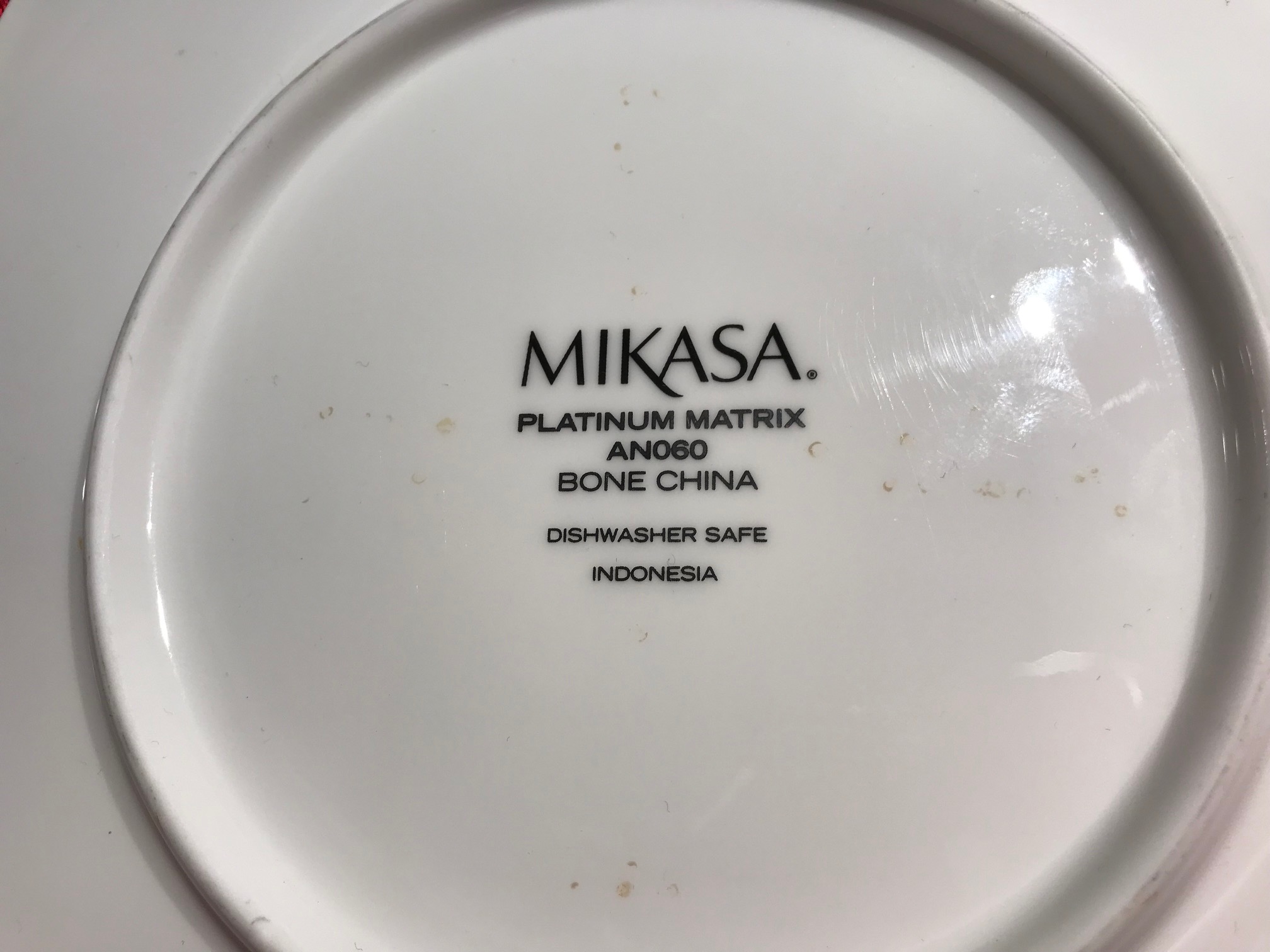Mikasa Platinum Matrix AN060 Design (Made in Indonesia) Bone China Dish: 56 ppm Lead. Safe by all standards.
 When tested with an XRF instrument, this Mikasa “Platinum Matrix” design bone china plate (pictured here) had the following readings:
When tested with an XRF instrument, this Mikasa “Platinum Matrix” design bone china plate (pictured here) had the following readings:
White stripes on food surface of dish:
- Barium (Ba): 135 +/- 48 ppm
- Tin (Sn): 57 +/- 16 ppm
- Zinc (Zn): 1,286 +/- 83 ppm
- Iron (Fe): 1,744 +/- 213 ppm
- Bismuth (Bi): 36 +/- 12 ppm
- Vanadium (V): 130 +/- 28 ppm
- Titanium (Ti): 328 +/- 46 ppm
- Negative/Non-Detect for: Lead, Cadmium, Mercury, Arsenic and Antimony
Gray stripes on food surface of dish:
- Lead (Pb): 35 +/- 13 ppm
- Tin (Sn): 104 +/- 16 ppm
- Zinc (Zn): 1,138 +/- 77 ppm
- Iron (Fe): 1,842 +/- 217 ppm
- Titanium (Ti): 5,794 +/- 284 ppm
- Negative/Non-Detect for: Cadmium, Mercury, Arsenic and Antimony
Please continue reading below the images for additional information.

 Platinum stripes on food surface of dish (images above):
Platinum stripes on food surface of dish (images above):
- Lead (Pb): 50 +/- 16 ppm
- Barium (Ba): 122 +/- 49 ppm
- Tin (Sn): 49 +/- 16 ppm
- Gold (Au): 172 +/- 66 ppm
- Zinc (Zn): 1,230 +/- 81 ppm
- Iron (Fe): 1,889 +/- 220 ppm
- Vanadium (V): 155 +/- 33 ppm
- Titanium (Ti): 375 +/- 53 ppm
- Platinum (Pt): 523 +/- 75 ppm
Please continue reading below the images for additional information.
 Back dish (logo area – image above):
Back dish (logo area – image above):
- Barium (Ba): 119 +/- 50 ppm
- Chromium (Cr): 1,353 +/- 120 ppm
- Tin (Sn): 36 +/- 16 ppm
- Zinc (Zn): 1,282 +/- 84 ppm
- Copper (Cu): 1,120 +/- 89 ppm
- Iron (Fe): 1,867 +/- 229 ppm
- Vanadium (V): 257 +/- 40 ppm
- Titanium (Ti): 578 +/- 66 ppm
- Manganese (Mn): 1,551 +/- 347 ppm
- Negative/Non-Detect for: Lead, Cadmium, Mercury, Arsenic and Antimony
Please continue reading below the images for additional information.
 ALTERNATE TEST: Platinum stripes on food surface of dish*
ALTERNATE TEST: Platinum stripes on food surface of dish*
(second dish, same pattern/same set with more worn surface – image above):
- Lead (Pb): 56 +/- 17 ppm
- Barium (Ba): 115 +/- 48 ppm
- Tin (Sn): 44 +/- 15 ppm
- Zinc (Zn): 1,261 +/- 81 ppm
- Iron (Fe): 1,812 +/- 215 ppm
- Vanadium (V): 152 +/- 32 ppm
- Titanium (Ti): 357 +/- 52 ppm
- Platinum (Pt): 416 +/- 69 ppm
- Negative/Non-Detect for: Cadmium, Mercury, Arsenic and Antimony
*The owner of these dishes sent me two examples – as she was curious if there would be a difference between one that was more worn, vs. one that was in newer condition. The difference is negligible – and it is interesting that the Lead level on the worn dish is actually very slightly higher on the worn strip than on the dish that is not worn. Because the testing window of the XRF instruments is a small circle – that is about one centimeter in diameter – and the “platinum” line takes up such a small amount of that window, these readings are very much “diluted” (the platinum banding would likely have a much higher amount of Lead than is represented by this reading if it were tested on it’s own – separate from the dish).
#FunFact: There is ACTUAL Platinum in the striping of these dishes!
To see more dishes I have tested, click here.
To see more Mikasa dishes I have tested, click here. Please note: many vintage Mikasa dishes have very high Lead content, and I would not consider them safe to eat off of. Consequently, I would never recommend this brand (even if some examples of their products are Lead-safe – such as these – or Lead-free), because across the population of so many items of theirs I have tested, the test results of their products have been far too variable / unpredictable – and their use of toxicants (primarily Lead) does not seem to be limited or correlated to any period of manufacture (both older and newer examples of dishes made by this company have tested positive for high levels of Lead).
To see more “Made in Indonesia” products that I have tested, please click here.
To see the dishes I use in my home with my family – please click here.
Each test was done using a freshly calibrated XRF instrument in “Consumer Goods” mode. Testing was repeated on each component to confirm the results. Testing time for each component was for at least 60 seconds. Results are replicable, science-based, and accurate. Metals not listed in the above test results sets were not detected by the XRF when testing in Consumer Goods mode.
Thank you for reading and for sharing my posts.
Please let me know if you have any questions.
Tamara Rubin
#LeadSafeMama 

Never Miss an Important Article Again!
Join our Email List



 When tested with an XRF instrument, this Mikasa “Platinum Matrix” design bone china plate (pictured here) had the following readings:
When tested with an XRF instrument, this Mikasa “Platinum Matrix” design bone china plate (pictured here) had the following readings:
 Platinum stripes on
Platinum stripes on Back
Back ALTERNATE TEST: Platinum stripes on
ALTERNATE TEST: Platinum stripes on